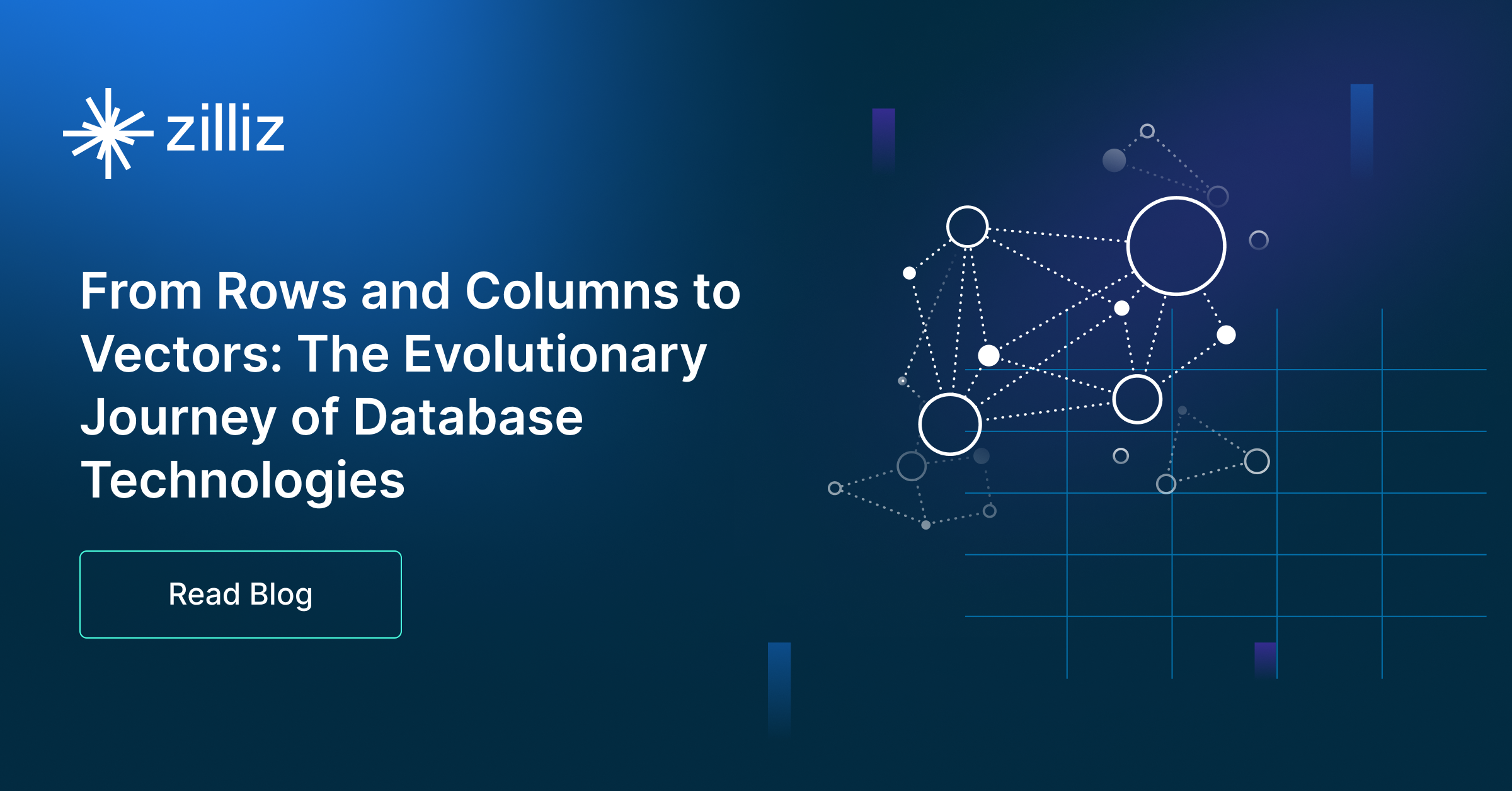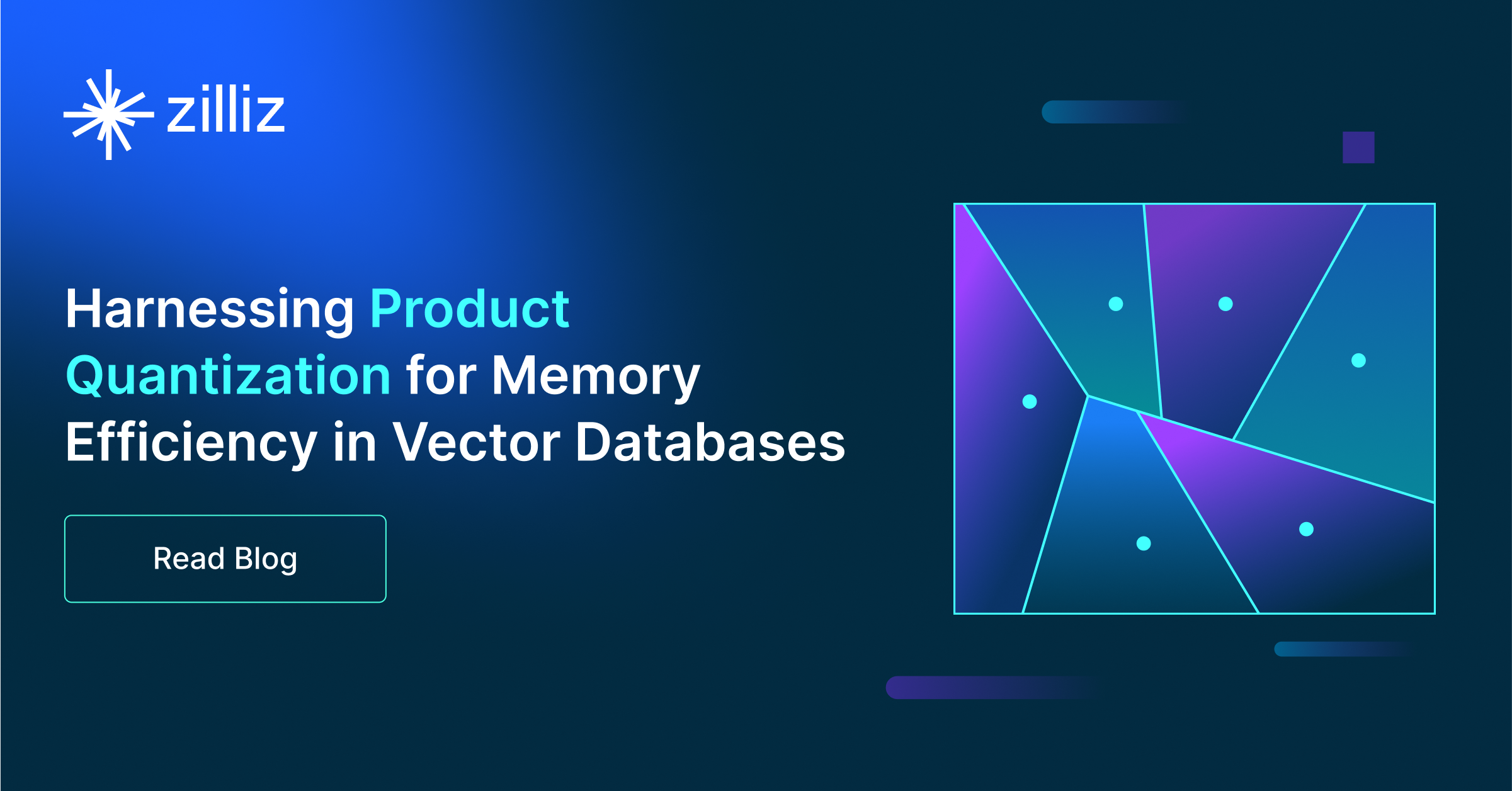Milvus Quickstart: Install Milvus Vector Database in 5 Minutes
Milvus vector database supports two modes of deployments: standalone and cluster.
Read the entire series
- Introduction to Unstructured Data
- What is a Vector Database and how does it work: Implementation, Optimization & Scaling for Production Applications
- Understanding Vector Databases: Compare Vector Databases, Vector Search Libraries, and Vector Search Plugins
- Introduction to Milvus Vector Database
- Milvus Quickstart: Install Milvus Vector Database in 5 Minutes
- Introduction to Vector Similarity Search
- Everything You Need to Know about Vector Index Basics
- Scalar Quantization and Product Quantization
- Hierarchical Navigable Small Worlds (HNSW)
- Approximate Nearest Neighbors Oh Yeah (Annoy)
- Choosing the Right Vector Index for Your Project
- DiskANN and the Vamana Algorithm
- Safeguard Data Integrity: Backup and Recovery in Vector Databases
- Dense Vectors in AI: Maximizing Data Potential in Machine Learning
- Integrating Vector Databases with Cloud Computing: A Strategic Solution to Modern Data Challenges
- A Beginner's Guide to Implementing Vector Databases
- Maintaining Data Integrity in Vector Databases
- From Rows and Columns to Vectors: The Evolutionary Journey of Database Technologies
- Decoding Softmax Activation Function
- Harnessing Product Quantization for Memory Efficiency in Vector Databases
- How to Spot Search Performance Bottleneck in Vector Databases
- Ensuring High Availability of Vector Databases
- Mastering Locality Sensitive Hashing: A Comprehensive Tutorial and Use Cases
- Vector Library vs Vector Database: Which One is Right for You?
- Maximizing GPT 4.x's Potential Through Fine-Tuning Techniques
- Deploying Vector Databases in Multi-Cloud Environments
- An Introduction to Vector Embeddings: What They Are and How to Use Them
Hey there - welcome back to Vector Database 101.
In the previous tutorial, we provided a brief introduction to Milvus, Milvus' history, as well as the primary differences between Milvus 1.x and Milvus 2.x. We also took a quick tour of the architecture of Milvus 2.x and helped shine some light on how Milvus' architecture allows it to implement all of the required features of vector databases.
If you haven't read the previous tutorials (unstructured data, vector database, Milvus introduction), I recommend you go ahead and read them. If you have, great. Let's get started with Milvus!
In this tutorial, we look at different deployments, followed with a step-by-step guide for installing your first vector database.
Let's get started
We offer two different modes of deployment: standalone and cluster. In Milvus standalone, all nodes - coordinators, worker nodes, and forward-facing proxies - are deployed as a single instance. For persistent data and metadata, Milvus standalone relies on MinIO and etcd, respectively. In future releases, we hope to eliminate these two third-party dependencies, allowing everything to run in a single process and removing the need to install third-party dependencies.
Milvus cluster is our full-fledged version of Milvus, complete with separate instances/pods for all eight microservice components along with three third-party dependencies: MinIO, etcd, and Pulsar (Pulsar serves as the log broker and provides log pub/sub services). If you haven't gotten the chance to take a look at the Milvus overview from the previous slide, please do so! It'll help clarify what each of these third party dependencies is used for and why we've included them in Milvus cluster.
Milvus standalone (docker-compose)
Milvus standalone is meant to be super easy to install. In this section, we'll go over how docker-compose can be used to install Milvus. You can view the recommended prerequisites on Milvus documentation page.
Let's first download the docker-compose.yml configuration file needed for the standalone installation. If you're on any Debian-based Linux (including Ubuntu), you can use the following command:
wget https://github.com/milvus-io/milvus/releases/download/v2.4.12/milvus-standalone-docker-compose.yml -O docker-compose.yml
sudo docker compose up -d
Resolving objects.githubusercontent.com (objects.githubusercontent.com)... 185.199.108.133, 185.199.111.133, 185.199.109.133, ...
Connecting to objects.githubusercontent.com (objects.githubusercontent.com)|185.199.108.133|:443... connected.
HTTP request sent, awaiting response... 200 OK
Length: 1303 (1.3K) [application/octet-stream]
Saving to: docker-compose.yml
docker-compose.yml 100%[===================>] 1.27K --.-KB/s in 0s
2022-06-29 13:58:49 (113 MB/s) - docker-compose.yml saved [1303/1303]
Alternatively, if you're on MacOS, make sure you have Docker Desktop installed first. I recommend using brew:
% brew install --cask docker
You can then follow this up with the command below:
% curl https://github.com/milvus-io/milvus/releases/download/v2.0.2/milvus-standalone-docker-compose.yml -o docker-compose.yml
With everything ready, we can now spin up our Milvus standalone instance:
$ docker-compose up -d
Docker Compose is now in the Docker CLI, try docker compose up
Creating milvus-etcd ... done
Creating milvus-minio ... done
Creating milvus-standalone ... done
Now, we can check on the status of our containers
$ docker ps -a
CONTAINER ID IMAGE COMMAND CREATED STATUS PORTS NAMES
711d54ab15c7 milvusdb/milvus:v2.0.2 "/tini -- milvus run…" 42 seconds ago Up 40 seconds 0.0.0.0:19530->19530/tcp milvus-standalone
0d85f4927864 minio/minio:RELEASE.2020-12-03T00-03-10Z "/usr/bin/docker-ent…" 42 seconds ago Up 40 seconds (healthy) 9000/tcp milvus-minio
99de39278b35 quay.io/coreos/etcd:v3.5.0 "etcd -advertise-cli…" 42 seconds ago Up 40 seconds 2379-2380/tcp milvus-etcd
Here's a quick rundown of what each of the containers are doing. milvus-standalone is the compiled/compressed version of Milvus, mean to run on a single machine.
To stop Milvus standalone, run:
$ docker-compose down
And that's it for Milvus standalone! Easy, right?
Milvus standalone (apt)
We also provide a handy apt package for Debian-based distributions. Simply run:
$ sudo apt install software-properties-common
$ sudo add-apt-repository ppa:milvusdb/milvus
$ sudo apt update
$ sudo apt install milvus
Once that's done, you're good to go. You can check the status of the running services with:
$ sudo systemctl status milvus
$ sudo systemctl status milvus-etcd
$ sudo systemctl status milvus-minio
Milvus cluster
From the previous tutorial, we know that Milvus is composed of four primary components: the access layer, coordinator service, worker nodes, and object storage. Requests are sent to a cluster of proxies in the access layer, which then forwards the requests to either the coordinator layer or a streaming service for vector data. The stateful coordinator nodes within the coordinator service manage and control all of the stateless worker nodes, allowing for easy horizontal scaling. Object storage is accomplished via S3 or any "S3-like" storage layer, allowing Milvus to be run both in the cloud and on-premises via MinIO.
Milvus' remaining third-party dependencies, Pulsar/Kafka and etcd, are also distributed and cloud-native, allowing the entirety of Milvus to run via Kubernetes as an orchestration engine. Using Kubernetes is a no-brainer for nearly all distributed applications, as it provides out-of-the-box support for application deployment, maintanence, and scaling. We recommend deploying Milvus as a Kubernetes application via Helm:
% helm repo add milvus https://milvus-io.github.io/milvus-helm/
"milvus" has been added to your repositories
Now, let's grab the latest Milvus chart from the milvus-io/milvus-helm repository.
% helm repo update
Hang tight while we grab the latest from your chart repositories...
...Successfully got an update from the "milvus" chart repository
Update Complete. Happy Helming
Great. Now that we've gotten all of the dependencies out of the way, let's install Milvus (cluster)!
% helm install my-release milvus/milvus
W0629 16:01:00.674407 21803 warnings.go:70 policy/v1beta1 PodDisruptionBudget is deprecated in v1.21+, unavailable in v1.25+; use policy/v1 PodDisruptionBudget
W0629 16:01:00.676536 21803 warnings.go:70 policy/v1beta1 PodDisruptionBudget is deprecated in v1.21+, unavailable in v1.25+; use policy/v1 PodDisruptionBudget
W0629 16:01:00.678594 21803 warnings.go:70 policy/v1beta1 PodDisruptionBudget is deprecated in v1.21+, unavailable in v1.25+; use policy/v1 PodDisruptionBudget
W0629 16:01:00.680671 21803 warnings.go:70 policy/v1beta1 PodDisruptionBudget is deprecated in v1.21+, unavailable in v1.25+; use policy/v1 PodDisruptionBudget
W0629 16:01:00.808448 21803 warnings.go:70 policy/v1beta1 PodDisruptionBudget is deprecated in v1.21+, unavailable in v1.25+; use policy/v1 PodDisruptionBudget
W0629 16:01:00.809339 21803 warnings.go:70 policy/v1beta1 PodDisruptionBudget is deprecated in v1.21+, unavailable in v1.25+; use policy/v1 PodDisruptionBudget
W0629 16:01:00.809344 21803 warnings.go:70 policy/v1beta1 PodDisruptionBudget is deprecated in v1.21+, unavailable in v1.25+; use policy/v1 PodDisruptionBudget
W0629 16:01:00.809594 21803 warnings.go:70 policy/v1beta1 PodDisruptionBudget is deprecated in v1.21+, unavailable in v1.25+; use policy/v1 PodDisruptionBudget
NAME: my-release
LAST DEPLOYED: Wed Jun 29 16:01:00 2022
NAMESPACE: default
STATUS: deployed
REVISION: 1
TEST SUITE: None
With this done, we can now see the pods that are up and running via kubectl:
$ kubectl get pods
NAME READY STATUS RESTARTS AGE
my-release-etcd-0 1/1 Running 0 2m23s
my-release-etcd-1 1/1 Running 0 2m23s
my-release-etcd-2 1/1 Running 0 2m23s
my-release-milvus-datacoord-6fd4bd885c-gkzwx 1/1 Running 0 2m23s
my-release-milvus-datanode-68cb87dcbd-4khpm 1/1 Running 0 2m23s
my-release-milvus-indexcoord-5bfcf6bdd8-nmh5l 1/1 Running 0 2m23s
my-release-milvus-indexnode-5c5f7b5bd9-l8hjg 1/1 Running 0 2m24s
my-release-milvus-proxy-6bd7f5587-ds2xv 1/1 Running 0 2m24s
my-release-milvus-querycoord-579cd79455-xht5n 1/1 Running 0 2m24s
my-release-milvus-querynode-5cd8fff495-k6gtg 1/1 Running 0 2m24s
my-release-milvus-rootcoord-7fb9488465-dmbbj 1/1 Running 0 2m23s
my-release-minio-0 1/1 Running 0 2m23s
my-release-minio-1 1/1 Running 0 2m23s
my-release-minio-2 1/1 Running 0 2m23s
my-release-minio-3 1/1 Running 0 2m23s
my-release-pulsar-autorecovery-86f5dbdf77-lchpc 1/1 Running 0 2m24s
my-release-pulsar-bookkeeper-0 1/1 Running 0 2m23s
my-release-pulsar-bookkeeper-1 1/1 Running 0 98s
my-release-pulsar-broker-556ff89d4c-2m29m 1/1 Running 0 2m23s
my-release-pulsar-proxy-6fbd75db75-nhg4v 1/1 Running 0 2m23s
my-release-pulsar-zookeeper-0 1/1 Running 0 2m23s
my-release-pulsar-zookeeper-metadata-98zbr 1/1 Completed 0 2m24s
That's it! You now have Milvus installed directly on your on-premises cluster. Check out our next tutorial to see how to create a collection within Milvus and begin inserting and querying embeddings.
If you're interested in running Milvus on cloud infrastructure check out the Milvus standalone on AWS Marketplace.
Wrapping up
In this tutorial, we took a look at how to install the standalone version of Milvus (via docker-compose) and the cluster version of Milvus (via helm). The standalone version is suitable for testing purposes, while the cluster version is suitable for internal clusters or on-premises deployments. In the next tutorial, we'll look at basic Milvus operations: connecting to a Milvus server, creating a collection (equivalent to a table in relational databases), creating a partition within the collection, inserting embedding vector data, and conducting a vector search.
See you in the next couple of tutorials.
Take another look at the Vector Database 101 courses
- Introduction to Unstructured Data
- What is a Vector Database?
- Comparing Vector Databases, Vector Search Libraries, and Vector Search Plugins
- Introduction to Milvus
- Milvus Quickstart
- Introduction to Vector Similarity Search
- Vector Index Basics and the Inverted File Index
- Scalar Quantization and Product Quantization
- Hierarchical Navigable Small Worlds (HNSW)
- Approximate Nearest Neighbors Oh Yeah (ANNOY)
- Choosing the Right Vector Index for Your Project
- DiskANN and the Vamana Algorithm
- Let's get started
- Milvus standalone (`docker-compose`)
- Milvus standalone (`apt`)
- Milvus cluster
- Wrapping up
- Take another look at the Vector Database 101 courses
Content
Start Free, Scale Easily
Try the fully-managed vector database built for your GenAI applications.
Try Zilliz Cloud for FreeKeep Reading

Understanding Vector Databases: Compare Vector Databases, Vector Search Libraries, and Vector Search Plugins
Deep diving into better understanding vector databases and comparing them to vector search libraries and vector search plugins.

From Rows and Columns to Vectors: The Evolutionary Journey of Database Technologies
From structured SQL and NoSQL and cutting-edge vector databases, this journey undertakes a significant transformation in data management strategies.

Harnessing Product Quantization for Memory Efficiency in Vector Databases
Exploring product quantization's intricacies and practical implementation through hands-on examples.
